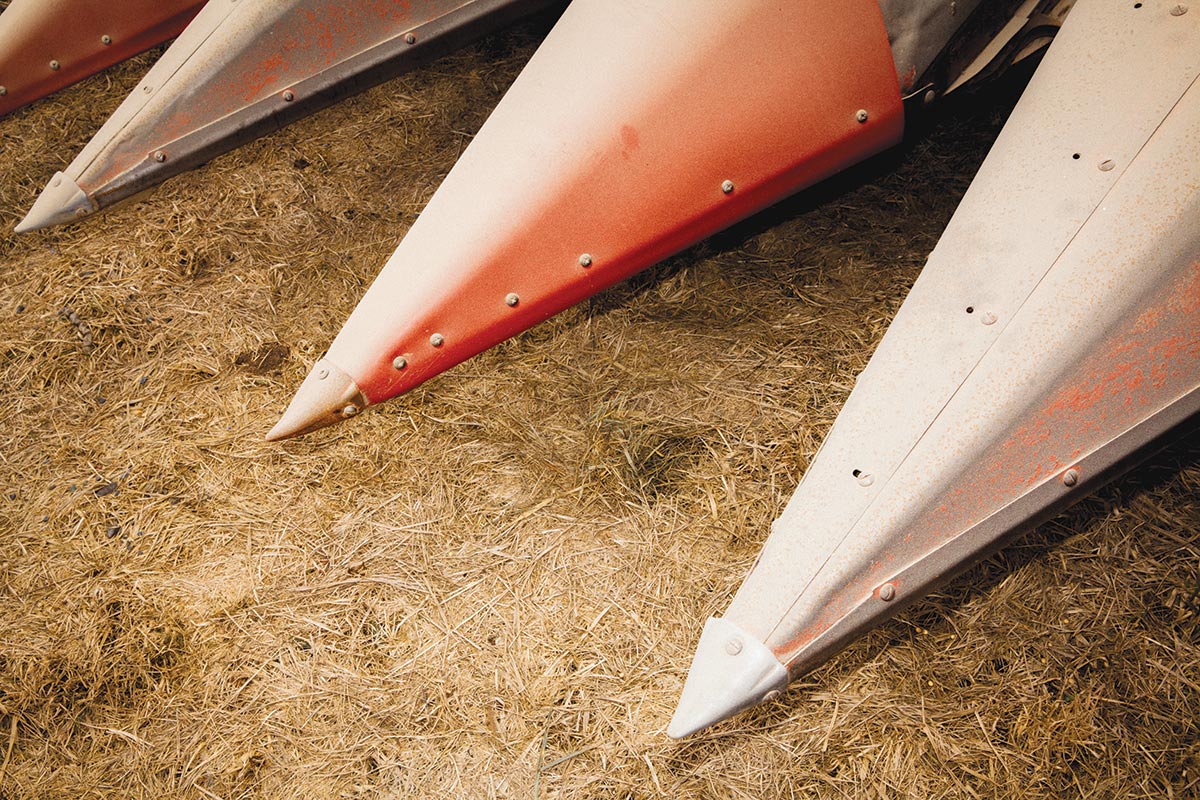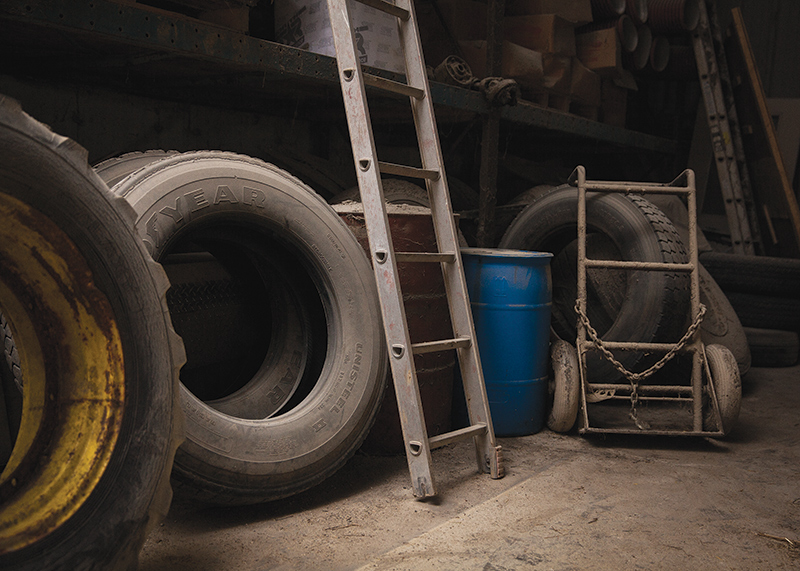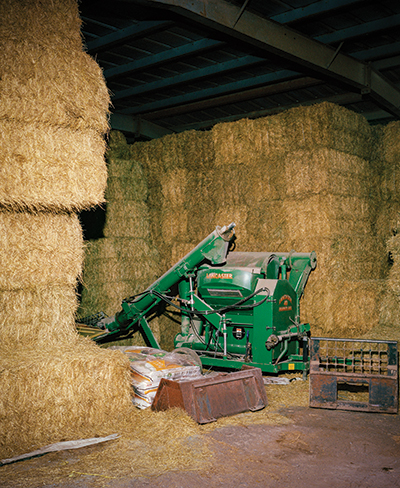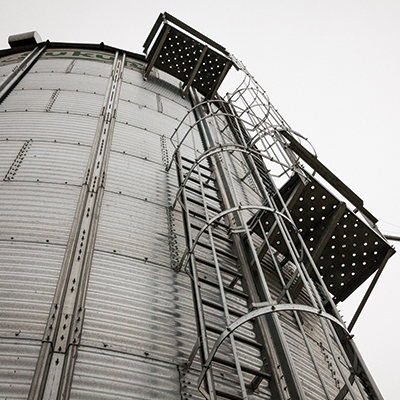Death on the Farm
Agricultural jobs are the most dangerous in the world. Why aren’t we talking about it?
Death on the Farm
Agricultural jobs are the most dangerous in the world. Why aren’t we talking about it?

Tim Smith has a story to tell, but it’s stuck way down in his throat. Typically, this fourth-generation Iowa farmer is chatty and warm, but sitting at the kitchen table with his wife, Tina, his face is ashen, his eyes clouded. Smith starts talking a few times, only to trail off mid-sentence.
A fog of silence settles over the room, until Smith quietly, hopefully tries to change the subject: “Lots of robins this year. Don’t you think?”

Twenty-six years ago, a farm accident nearly took Smith’s life. His jeans caught on a piece of manure-pumping equipment and, in the blink of an eye, his leg was connected to his torso by a mere inch of flesh. Smith, who farms in Clay County, Iowa, had to be flown to a hospital in Sioux Falls, South Dakota. Doctors told him he was lucky to survive with his leg intact. And in the decades since, the memory hasn’t faded a bit. “I came very close,” Smith whispers.
Tractor rollovers. Grain suffocation. Deadly fumes. Goring. Electrocution. Heatstroke. Smith’s incident is scary but in no way unique: Farming is one of the deadliest professions in the world.
Unfortunately, farm safety is an issue rarely discussed outside of agricultural circles. Out of 335,000 workplace fatalities worldwide, over half occur in agriculture, according to the International Labour Organization. The particular hazards vary around the globe – in Sweden, livestock accidents are a major killer, while a number of Kenyan farmers have died from a toxic corn fungus – but the danger is a constant.
In some countries, farming accounts for twice as many deaths as all other industries. Agriculture has been the deadliest U.S. industry every year for the last decade, beating out mining and construction in deaths per 100,000 workers.
In the 16,600-person county where Smith lives, at least five people have died in ag-related accidents since 2010. Not to mention near-fatal incidents, deaths from long-term chemical exposure and farmer suicides. “Until I married a farmer, I had no idea how dangerous it was,” says Janna Swanson, a transplant from Minnesota now living in Clay County. “But oh my gosh. In recent years, men in our community have died in grain bins and tractor rollovers. How could I not worry?”
Farms have always been hard, physically demanding workplaces, but safety concerns evolved in the early 20th century, when tractors began replacing horses as the go-to farmer’s aid. These gas-powered beauties forever reshaped the face of agriculture; they also ushered in an era of mechanized danger and death.
Tractors now claim some 125 lives a year in the U.S., according to the National Institute for Occupational Safety and Health (NIOSH), representing the biggest danger on a farm.
Before tractors, horses were the most dangerous pieces of farm equipment. now, livestock accidents usually involve bulls goring their owners, or pigs, cows or other animals trampling farmers.
Tractors are by far the biggest cause of U.S. farm injuries and deaths. rollover technology has made current machines safer, but many farmers use older models lacking safety features.
“Back 100 years ago, the most you had to worry about was getting jabbed by a pitchfork, maybe run over by your horses,” says Clay County farmer Lyle Kenobbie. “There’s less to hurt you when everything’s done by hand.”
A host of other machinery, like combines, choppers and hay balers, also bring their own attendant dangers. Mike Juza had some neighbors helping out on his Clay County farm last August. Two young men were scooping silage from a wagon when one of their sweatshirts got caught on a moving part, the beater – he was tangled in the machinery and flipped on his back. The worker was cut up badly, requiring that too-common emergency flight to Sioux Falls. Doctors said he was within inches of rupturing the femoral artery, which would likely have been fatal.
But tractors are far and away the deadliest machinery for farmers. The most frequent event is a tractor rollover, which often happens on a slope, with slippery or rough terrain playing a role. Pulling a heavy load can compound the danger by causing poor equilibrium. Car-to-tractor accidents are also common, when impatient or distracted drivers collide with tractors on the road.

Sweden was the first country to implement regulations for the use of roll-over protective structures (ROPS) in 1959. They’re a simple but effective device – essentially a roll bar or cage over the seat. In the event of an overturn, a seat-belted farmer will almost never be crushed. In 1985, it became standard practice for manufacturers in the U.S. to turn out tractors with ROPS and safety belts. Yet, despite the new safety measures, tractor deaths still occur at a troubling rate.
Considering NIOSH estimates that ROPS, in conjunction with seat belts, could prevent 95 percent of tractor fatalities, why do tractors remain so deadly?
For one thing, many older tractors remain in use across the country. A quick drive through Clay County reveals a fleet of old red and green workhorses, chugging along many decades after they were built. A roll bar can’t save you if it was never installed. In addition, many farmers remove ROPS from newer tractors for convenience. Kenobbie says ROPS are a “pain in the ass,” making it hard to maneuver tractors into sheds and other farm buildings. All told, NIOSH estimates that only 60 percent of the 4.6 million tractors in the U.S. are equipped with ROPS.
The other major issue is the seat belt. In order for ROPS to protect a farmer, he or she needs to be belted in. Otherwise they can slip right past the roll bar, into harm’s way. And seat belts are far from the norm. A 2013 study in the “Journal of Adolescent Health” confirms that most farmers just don’t buckle up.
Two of the most well-publicized hazards on a farm are grain bins and silos, the massive storage structures rising above an otherwise-flat horizon. Grain bins only claim about one-tenth the lives that tractors do each year, but the grisly nature of these accidents gives them an outsize presence: A farm worker enters the bin for some mundane task, only to be overcome in a tidal rush of grain. The grain often both crushes and suffocates victims, leaving bits of corn or other grain embedded in the lungs.
The age of the victims also catches the media’s eye – nearly 20 percent are under the age of 20. Farming is the only industry in the U.S. that employs children as young as 9; it’s common in farm country to start working at an early age. In 2012, 19 U.S. workers under the age of 16 died in workplace accidents – 14 of them worked in agriculture.
When you look at multiple grain-bin accidents, patterns emerge: A farm worker needs to tend to something in the bin or check the condition of the stored grain. Over the winter, sections of grain can grow damp and clump together, creating what’s called a “crust” at the top. The worker might attempt to break up the crust with a rod or a pick, only to end up sinking and becoming engulfed in the grain below. By the time rescue workers extract the victim, it’s usually too late.
Underground manure pits, used on livestock and dairy farms to store large quantities of waste, have also been garnering recent media attention. Pit accidents involve high levels of noxious gases like hydrogen sulfide or ammonia. Some farmers die from exposure to the fumes alone, while others pass out, only to drown in manure slurry. Clay County has largely been spared from manure-pit incidents, but nationwide, they are among the most lethal – accidents in Maryland and Virginia have claimed three and four family members, respectively. First responders recount scenes of stark horror. “They all climbed into the pit to help. Before they hit the floor, they were probably all dead,” Sheriff Donald Farley told the Associated Press, describing the 2007 deaths of a farm couple, two of their daughters and a farmhand.
Workplace danger is, of course, subject to government oversight. When you hear about occupational accidents in other industries, typically there’s some mention of fines from the Occupational Safety and Health Administration (OSHA) – equipment wasn’t up to snuff, safeguards weren’t in place, et cetera. Most farms, however, aren’t subject to OSHA rules. Since 1976, the agency has not regulated farms with 10 or fewer workers. This represents the vast majority of American farms.
Visit a random sampling of farms in Clay County and you might see a lot of the same setup: a wife and husband, their kids, maybe a couple of “hired hands” (often a neighbor’s kids) during peak harvest and planting. Thanks to modern machinery, it only takes one dedicated farmer to manage grain farms with upward of 1,000 acres.
Carolyn Sheridan works full-time for AgriSafe Network, educating farmers in Clay County – and across the country – about staying safe on the job. “Most of the time, it’s just you out there,” Sheridan says. “There’s no one standing over you, deciding whether you’re hired or fired.” This is one of the most fundamental differences between farms and other workplaces.
This independence carries over to matters of safety. If you decide not to buckle up on your own tractor, no one’s going to come down on you. “That’s a big reason why these guys are farmers in the first place,” says Bill Field, a farm safety expert and educator with Purdue University. “They want to do it their way!”
OSHA made some moves to start regulating grain bins last year, claiming (somewhat perplexingly) that the structures were not considered part of farms and were therefore subject to regulation. The reaction was swift and angry. Senator Mike Johanns (R-Neb.) was sharply vocal on the matter, claiming, “Worker safety is an important concern, but farmers know better than bureaucrats how to keep their employees and family safe.” OSHA relented this February, agreeing to pursue no further inspections or enforcement actions on small farms.

Some politicians have unsuccessfully tried to legislate farm safety on a state level, like a proposed bill in Washington this year that would have strengthened safety training for farm workers. Bounced between the House and Senate, the bill has yet to make it to a final vote.
It would seem many legislators recognize the difficulties in requiring farmers to adopt new behaviors. “Farmers do not like mandates on their livelihood,” Democratic Senator Joe Seng, chair of the Iowa State Senate’s Agriculture Committee, told IowaWatch.org in January. “If nobody is insisting on [safety legislation], we let the sleeping dogs lie.”
Other factors unique to farm work are equally hazardous. Farmers work outside, for instance, and in warmer regions, heatstroke is a common cause of fatalities. Farmers also work closely with large animals – ornery bulls claim a few lives each year. Pesticides and other chemicals can prove lethal, both from instant mishaps and prolonged exposure. Taller farm equipment can run into power lines. You could even make a case that suicide is a farm danger, especially in countries like India, where it’s become an epidemic. A Clay County pig farmer recently killed himself with a .40-caliber gun, leaving a note that claimed farm finances were to blame. Dr. David Robison, Clay County medical examiner, says this farmer wasn’t the first.
So if the Netherlands can reduce routine antibiotic use without harming its farmers’ survival, maybe other countries can, too.
For many migrant farm workers, language barriers can also be fatal. R. Lewis Van Blois, a California personal injury lawyer, has represented the estates of many deceased or severely injured ag workers. He says older equipment often only has English instructions, and migrant farm workers have historically been given very little safety training. “These are low-income earners, many not legal, afraid to speak up,” he says. “Nobody’s really advocating for their safety.”
Many farm fatalities also have a common link – distraction. Just like on the highway, farm accidents only take’a momentary lapse in concentration. “It’s one thing when you’ve had your full eight hours of sleep,” says Robison. “But when you’ve been up all night delivering cows, or you’re in the field 16 hours during harvest season, let’s just say you’re not at peak performance.”
Time constraints can lead to shortcuts as well. Smith, who now walks with a pronounced limp, says he should have taken more precautions. Bolts were loose, and he didn’t have the right tool on hand. A huge winter storm was on its way, and he was trying to finish the project in a hurry. “There’s not a farmer out there that won’t take a short- cut from time to time,” says Smith.
In the last few decades, safety has become more of a priority. Particularly risky equipment – like the “corn picker,” which once claimed many a farmer’s thumb in Clay County – has been phased out. Cell phones enable farmers to reach emergency personnel for quicker rescue, and handling certain pesticides now requires certification. More grain bins are being equipped with harnesses – a mandatory feature on farms with 10 or more workers. Tractors, combines and other farm machinery now come with a “dead-man switch,” which means the engine shuts down if no one is manning the equipment.
And yet, the fatalities continue. A study undertaken in Iowa, based on workplace deaths reported in newspapers, showed that nearly one-third of fatal workplace accidents between 2001 and 2011 were agricultural. (Add in farm deaths that didn’t make the news and this figure would certainly be even higher.) This, despite the fact that less than 1 in 1,000 people work in farming statewide.
In the face of sometimes-dispirit- ing stats, farm safety educators like Sheridan soldier on. They assist with farm safety days, give lectures to young farmers and generally try their best to increase danger awareness. Becky Fearhatting of the Spencer Chamber of Commerce participates in a “Take a Break” event each year, where volunteers bring food and water out to Clay County’s farmers in order “to remind them to not to work 24/7, get starry-eyed and fall asleep on their tractors.” In many states, you can participate in a voluntary safety audit, where inspectors will visit your farm and show areas for improvement. But there remains little in the way of broader enforcement or regulation.

For their part, many farmers seem to approach the job’s dangers with a stoic fatalism. Much like the vagaries of weather – drought one year, flooding the next – there’s a general acceptance that risk comes with the territory. “Farmers are gamblers,” says Robison. In this sense, every time a tractor is used without a roll bar, every time a grain bin is entered without a harness, it’s a calculated risk.
Farm workers are truly a breed apart. For all the changes in the last 50 years, these are still people willing to start before dawn and finish after dark. Juza recalls a time when he was helping birth a calf and the mother kicked his pinkie out of its socket. “I was light-headed from the pain, but I wasn’t going to let that calf die,” he says. “I folded my knuckle into place and finished calving.”
Follow us
This work is licensed under a Creative Commons Attribution-NoDerivatives 4.0 International License.
Want to republish a Modern Farmer story?
We are happy for Modern Farmer stories to be shared, and encourage you to republish our articles for your audience. When doing so, we ask that you follow these guidelines:
Please credit us and our writers
For the author byline, please use “Author Name, Modern Farmer.” At the top of our stories, if on the web, please include this text and link: “This story was originally published by Modern Farmer.”
Please make sure to include a link back to either our home page or the article URL.
At the bottom of the story, please include the following text:
“Modern Farmer is a nonprofit initiative dedicated to raising awareness and catalyzing action at the intersection of food, agriculture, and society. Read more at <link>Modern Farmer</link>.”
Use our widget
We’d like to be able to track our stories, so we ask that if you republish our content, you do so using our widget (located on the left hand side of the article). The HTML code has a built-in tracker that tells us the data and domain where the story was published, as well as view counts.
Check the image requirements
It’s your responsibility to confirm you're licensed to republish images in our articles. Some images, such as those from commercial providers, don't allow their images to be republished without permission or payment. Copyright terms are generally listed in the image caption and attribution. You are welcome to omit our images or substitute with your own. Charts and interactive graphics follow the same rules.
Don’t change too much. Or, ask us first.
Articles must be republished in their entirety. It’s okay to change references to time (“today” to “yesterday”) or location (“Iowa City, IA” to “here”). But please keep everything else the same.
If you feel strongly that a more material edit needs to be made, get in touch with us at [email protected]. We’re happy to discuss it with the original author, but we must have prior approval for changes before publication.
Special cases
Extracts. You may run the first few lines or paragraphs of the article and then say: “Read the full article at Modern Farmer” with a link back to the original article.
Quotes. You may quote authors provided you include a link back to the article URL.
Translations. These require writer approval. To inquire about translation of a Modern Farmer article, contact us at [email protected]
Signed consent / copyright release forms. These are not required, provided you are following these guidelines.
Print. Articles can be republished in print under these same rules, with the exception that you do not need to include the links.
Tag us
When sharing the story on social media, please tag us using the following: - Twitter (@ModFarm) - Facebook (@ModernFarmerMedia) - Instagram (@modfarm)
Use our content respectfully
Modern Farmer is a nonprofit and as such we share our content for free and in good faith in order to reach new audiences. Respectfully,
No selling ads against our stories. It’s okay to put our stories on pages with ads.
Don’t republish our material wholesale, or automatically; you need to select stories to be republished individually.
You have no rights to sell, license, syndicate, or otherwise represent yourself as the authorized owner of our material to any third parties. This means that you cannot actively publish or submit our work for syndication to third party platforms or apps like Apple News or Google News. We understand that publishers cannot fully control when certain third parties automatically summarize or crawl content from publishers’ own sites.
Keep in touch
We want to hear from you if you love Modern Farmer content, have a collaboration idea, or anything else to share. As a nonprofit outlet, we work in service of our community and are always open to comments, feedback, and ideas. Contact us at [email protected].by Jesse Hirsch, Modern Farmer
June 16, 2014
Modern Farmer Weekly
Solutions Hub
Innovations, ideas and inspiration. Actionable solutions for a resilient food system.
ExploreExplore other topics
Share With Us
We want to hear from Modern Farmer readers who have thoughtful commentary, actionable solutions, or helpful ideas to share.
SubmitNecessary cookies are absolutely essential for the website to function properly. This category only includes cookies that ensures basic functionalities and security features of the website. These cookies do not store any personal information.
Any cookies that may not be particularly necessary for the website to function and are used specifically to collect user personal data via analytics, ads, other embedded contents are termed as non-necessary cookies.
Please send your newsletter. I enjoyed the information I’ve read this far.
I had no idea that farmers work was so dangerous. I’m really sadden by knowing this. I will continuously keep the farming community on my heart and in my prayers.